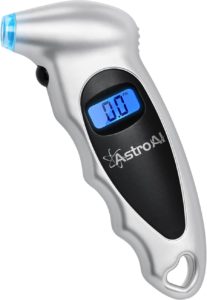Volkswagen ID.4 Tire Pressure Monitoring System Description
The Volkswagen ID.4 is equipped with a tire pressure monitoring system to help keep drivers safe and informed. Understanding how to use and maintain this system is crucial for the vehicle’s performance and safety. In this article, we’ll discuss the VW ID.4’s tire pressure monitoring system, how to reset the light, when to reset the light, and what causes the light to come on.
How Does the Volkswagen ID.4 TPMS Work?
In the Volkswagen ID.4, the TPMS works using indirect methods. This means it doesn’t have individual pressure sensors inside each tire. Instead, the system relies on its wheel speed sensors that are part of the Anti-lock Braking System (ABS).
Here’s a detailed explanation of how the indirect TPMS works:
The system calculates the rotational speed of each wheel using the ABS wheel speed sensors.
When a tire loses pressure, its diameter decreases. As a result, the affected wheel needs to rotate faster to keep up with the other wheels and maintain the same vehicle speed.
The TPMS analyzes the data from the wheel speed sensors, and if it detects a significant difference in rotational speeds between the wheels, it interprets this as a change in tire pressure.
If the system identifies a tire with low pressure, it triggers a warning light on the instrument panel, alerting the driver to check the tire pressure.
2023 Volkswagen ID.4 Tire Pressure Light Reset Procedure:
Be sure to fill your tires to the recommended pressures before following this reset procedure.
Switch the Ignition ON
Turn on the Infotainment system if it’s not on already
Select VEHICLE on the infotainment
Select VEHICLE on the left
Select TIRES / TYRES
Select SET
Select OK
OR
Switch ignition ON
Turn on the Infotainment system if it’s not on already
Select VEHICLE on the infotainment
Select STATUS on the left
Select TIRES / TYRES
Select SET
Select OK
TIP: If the tire pressure light won’t go off after following these steps, double check your air pressure manually with a tire gauge and then repeat the reset procedure.
Volkswagen ID.4 Recommended Cold Pressure:
Cold pressure means that each of the tires should be set when the tires are cold before they’ve heated up from driving.
FRONT 235/50 R20: 42 psi
FRONT 235/55 R19: 42 psi
REAR 255/45 R20: 42 psi
REAR 255/50 R19: 42 psi
What Happens When Tires are Underinflated?
When the tires in a Volkswagen ID.4 are underinflated, several things can happen:
• Reduced Battery Efficiency: Under inflated tires increase the rolling resistance, which means the vehicle electric motor has to work harder to move forward, causing it to consume more battery power.
• Poor Handling and Braking: Underinflated tires can affect the vehicle’s handling and stability, making it more difficult to control the car. It can also lead to longer braking distances, which can be dangerous in emergency situations.
• Premature Tire Wear: When tires are underinflated, the edges of the tire tread make contact with the road more than the center of the tread, which can cause the tires to wear unevenly and reduce their lifespan.
• Overheating Tires: Underinflated tires generate more heat than properly inflated tires. This increased heat can cause tire failure like blowouts.
• Tire Failure: When a tire is severely underinflated the tire can just fail which can definitely lead to an accident.
What Causes Tire Rolling Circumference to Change? (low pressure)
When rolling circumference changes, the shape of the tire changes due to pressure changes. Pressure changes cause tire pressure lights to turn on.
Rolling circumference changes may occur due to:
Adjustments in tire pressure
Insufficient tire pressure
Structural damage to the tire
Uneven vehicle load distribution
Snow chain installation
Using a spare wheel
Replacement of a single wheel per axle
Temperature fluctuations
When to Recalibrate the TPMS in VW ID.4:
After inflating or adjusting tire pressure
After tire rotations
After replacing tires
After wheel alignments
After wheel balances
After seasonal temperature changes
After repairing or replacing a faulty ABS or wheel speed sensor
If the TPMS warning light stays on despite resolving tire pressure issues
Manufacturer’s recommendation
After jumping or replacing the vehicle battery
After any suspension work
TIP: Be sure to check all tire pressures before recalibrating the tire pressure system regardless of the reason or cause.
Weather Affects Tire Pressure:
Tire pressure changes are mainly due to temperature fluctuations, regardless of the type of car you drive. In cold weather, the air inside the tires contracts as the air molecules lose kinetic energy when the temperature drops. As a result, these molecules move closer together, leading to a decrease in tire pressure. In extreme cases, this can cause significant underinflation. That’s why it’s crucial to regularly check and adjust your tire pressure, particularly during the chilly winter months, to ensure your Volkswagen ID.4 performs well and stays safe on the road.
On the other hand, in hot or warm weather, the air inside the tires expands, causing an increase in tire pressure. This can lead to overinflation, which might result in reduced traction and uneven tire wear. So, remember to keep an eye on your tire pressure during both cold and warm weather to maintain your car’s performance and safety.

The chart illustrates the relationship between temperature and tire pressure changes in both Fahrenheit and Celsius, as well as PSI and kPa units. It demonstrates that as the temperature decreases, tire pressure drops accordingly, while the opposite occurs when the temperature increases. The baseline temperature for checking tire pressure is considered to be around 62°F (16.7°C), where no significant tire pressure changes are observed. The chart serves as a helpful guide for understanding how temperature fluctuations can affect tire pressure, emphasizing the importance of regularly checking and adjusting tire pressure, especially during extreme weather conditions, to maintain optimal vehicle performance and safety.
Tire Maintenance
It is crucial to adjust the tire pressure in your Volkswagen ID.4 when the tires are cold. Cold tires provide the most accurate tire pressure readings, as heat generated from driving can cause temporary inflation, potentially leading to misleading measurements. Maintaining proper tire pressure in your electric vehicle not only extends tire life and reduces wear but also enhances the overall driving experience. Furthermore, correctly inflated tires contribute to the ID.4’s impressive range and energy efficiency, making it an eco-friendly choice for you environmentally-conscious drivers. To get the most out of your Volkswagen ID.4, always remember to check and adjust tire pressure when the tires are cold.


